

 The South African
The South African
by Cmdt O.E.F. Baker, DWD
The following study has as its focus the South African Irish Regiment. Archival material relating to this unit is sadly lacking, in marked contrast to such units as the Light Horse Regiment, Rand Light Infantry and Transvaal Scottish. These units have longer and fuller histories than the South African Irish Regiment, but, the brief and truncated nature of the South African Irish Regiment's history certainly does not preclude an endeavour to produce a detailed study of its distinguished history. Indeed, the following article, it is hoped, will eventually form the basis of a monograph, dedicated to the Regiment's history. It is considered that it would be a distortion of historical perspective if the South African Irish Regiment were to be discussed an isolated context, without reference to a general overview of the impact, which has been very considerable, of the Irish tradition upon South African military history. Hence, in the interest of the preservation of historical continuity, the history of the South African Irish Regiment, which can be said to have commenced in 1914, is prefaced by a study of the interaction between the history of a number of Irish regiments, forming part of the British military tradition, in the South African context. This is followed by an examination of autonomous South African units which have been shaped by the Irish presence.
Irish Regiments in the British Army Serving in South Africa
All the regular units of Irish origin in the British Army have served
for a period of time in South Africa. Other formations, such as Militia,
Volunteers and Yeomanry have also seen service in South Africa either as
units or as reinforcements for the regular forces, especially during the
Anglo-Boer War of 1899-1902. Although the first record of British Army
units serving in South Africa cites the 78th Regiment of Foot (later 2
Bn Gordon Highlanders), who were landed at Simons Bay on 10 June 1795,
the Irish were not far behind.(1) The 86th Regiment of Foot (later 2 Bn
Royal Irish Rifles, to be reconstituted as the Royal Ulster Rifles, who
were to be affiliated to the South African Irish Regiment after World War
2) arrived at the Cape on 22 September 1795, one week after the Dutch surrender.
One authority states that: 'Until the 20th February 1799 when it embarked
for India, it is recorded that the appearance of the men was especially
commented on. Well grown, well set up, and 1 300 strong, the regiment excited
universal admiration and, its regimental records add, it was perhaps the
finest body of men that ever came to this country.'(2) They carried out
field and garrison duties and had as a companion Irish unit the 8th Dragoons
(Kings Royal Irish Dragoons, later the 8th Kings Royal Irish Hussars).
The unit also made a name for itself, to which the same authority bears
witness 'Frequent reference has been made to the service rendered by this
regiment in the disturbances at the Cape during 1796-1803. General Dundas
repeatedly declared that without the Dragoons he could not have held the
colony. These men had a thorough knowledge gained from experience of all
the roads, mountain passes, fords through rivers as well as a knowledge
of the dialects spoken in the country. Farmers trusted them to such a degree
that they would leave their houses and cattle in their charge whilst they
set out with their produce for Cape Town. These relay Dragoons protected
their houses from run-away slaves and their cattle from beasts of prey.'(3)
At a later point in South African history the 27th Regiment of Foot (later 1 Bn Royal Inniskilling Fusiliers) were involved in the campaign on the Eastern Cape frontier in 1835. Subsequently, after the Battle of Congella (1842), the regiment served in the relieving force in Durban, where a detachment of the regiment, under Capt Charlton Smith, had been under siege for a month under extremely adverse conditions. He was rewarded by promotion and received a testimonial expressing 'appreciation of his indomitable bravery in maintaining his post at Port Natal.'(4)
Hence, the 27th Regiment laid the foundations of the British colony in Natal. Indeed, they provided its first Magistrate, Capt Durnford, and many years afterwards supplied the Governor, Col MacLean. In 1843 two companies of the 45th and one of the 27th Regiment of Foot pitched camp on Maritzburg Hill, naming the hill Fort Napier after Sir George Napier, the Governor of the Cape. At the beginning of 1845 the detachment from the 27th rejoined the remainder of the regiment at Fort Peddie on the Eastern frontier of the Cape. A soldier of the 45th has supplied some interesting reminiscences of this time and mentions that the Grenadier Company of the 27th was 'the finest in the army, the tallest man being 'Long Hines' who stood 6 feet 8 inches, whilst the shortest was 6 foot.'
During the Zulu War of 1879 the 88th Regiment of Foot (Connaught Rangers) was involved, whilst the 94th Regiment of Foot (later 2 Bn Connaught Rangers) served in the First South African War of Independence of 1880-1881. Garrisoning four towns besieged by the Boers, the regiment also incurred many casualties in the course of the battle of Bronkhorstspruit. The 27th Regiment of Foot, discussed earlier, reappears during the Basuto War of the mid 1880s, together with the 6th Inniskilling Dragoons.
The roll of Irish regiments who participated in the South African War is almost a complete embodiment of the Irish contribution to the British military establishment. The following Irish units served:
In 1900 Queen Victorial duly authorized the wearing of the shamrock on St Patrick's day, due to the tremendous public sentiment generated by the gallantry of the Irish troops in the war. However, a greater mark of appreciation of the bravery of Irish troops in South Africa was accorded when, a short while later, the Queen also deemed it appropriate that an Irish regiment of Foot Guards be formed, to be designated the 'Irish Guards'. Elements of the Irish Guards were to participate in the latter phases of the Anglo-Boer War, as components of a composite Guards Mounted Intantry unit.(5)
Autonomous South African Units shaped by Irish Influences
The first South African unit with a truly Irish background was the
Cape Town Irish Rifles, raised by Maj O'Reilly in 1885. In 1891 the unit
was absorbed into the Duke of Edinburgh's Own Volunteer Rifles as 'H' (Irish)
Company. Regrettably, there is very little information available concerning
the Cape Town Irish Rifles specifically, but it is hoped that further research
will produce additional information. The helmet plate of the regiment is
a magnificent specimen and closely resembles that of the Connaught Rangers
who were contemporary. The Cape Town Irish Rifles may be said to represent
the first predecessor of the South African Irish Regiment, in so far as
it was the first indigenous South African unit with a distinct ethnic Irish
component.
During the Anglo-Boer War, 1899-1902, the second predecessor of The South African Irish Regiment was formed. Driscoll's Scouts was founded by Capt D.P. Driscoll, who had previously served in Burma during the earlier part of the Anglo-Boer War and who decided to come to South Africa with the specific intention of forming an Irish unit. This was motivated by the losses suffered by Irish units within the British Army during the early battles of the War. Eventually totalling a strength of just under 500 men of all ranks, it first served with the Colonial Division and was present at the siege of Wepener and operations around Lindley and Fouriesburg. In one particular action at Wepener, in which Driscoll's Scouts assisted the Cape Mounted Riflemen, the Scouts had an adventurous and hazardous ride across open ground from their bivouac, being exposed to the concentrated fire of two Maxim machine guns, a pom-pom, small arms fire and, at the end, to a barrage of shells from a field gun, during their entire four kilometre ride. Their action helped to stabilize the British position(6). Later the Scouts formed part of 8 Division and were part of the force concentrated to oppose the incursions into the Cape Colony by the forces of Gen Smuts. Driscoll's Scouts also took part in the final operations directed against Gen de la Rey in the Western Transvaal.
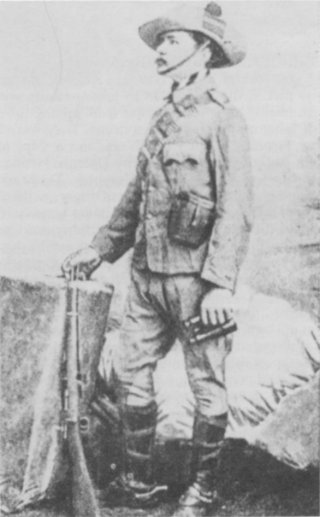
Major D.P. Driscoll, DSO,
commander of Driscoll's Scouts
during the Anglo-Boer War 1899-1902.
Irishmen in the Service of the Boer Republics
Up to this point the Irish contribution to the British military effort
in South Africa had been discussed, whether this contribution was in the
form of Irish units forming part of the regular British military establishment
or autonomous ('colonial') units, as in the case of Driscoll's Scouts.
However, it should be remembered that the Irish military tradition with
regard to the British was in the shape of a two-edged sword. Whereas many
Irishmen served in units composed of their countrymen which were to found
distinguished records in the annals of the British Army, others remained
bitter opponents of the Protestant monarchy. This was particularly true
of those Catholics who, during the course of the 18th century served as
'soldiers of fortune' (the 'wild geese'), and were particularly prominent
in the 'Irish Brigade' of the French Army. This tradition of mercenary
service in foreign armies, conjoined with opposition to Britain, reappeared
in the Anglo-Boer War in the form of the Irish Brigade, which served with
the forces of the Boer Republics. Divided into two sections ot 100 men
each, led by Cols Blake and Lynch, it comprised mainly Irish Americans,
whose motives varied widely.
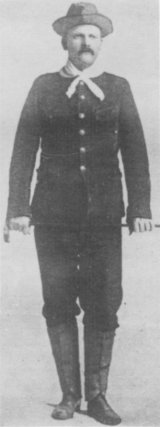
Col. J.Y.F. Blake
They either loved fighting, hated the British, or had high hopes of future rewards from their employers (and frequently all these motives were present at once). In common with the other foreign corps serving with the Boers, the Irish Brigade adopted Boer tactics. Generally speaking, they were courageous but inferior to the Boers in skill, and more than on one occasion, (e.g., at Elandslaagte and Magersfontein) allowed themselves to be surrounded, captured or destroyed. Relations between the Irish Brigade and the Boers were often strained (as were relations between other foreign volunteers and the Boers). The former invariably expected more than they were either accorded or received(7). Blake's section distinguished itself at Pepworth, near Ladysmith, where it stood its ground under a hail of British shrapnel, dragging a great deal of ammunition up the hill. This unit was later engaged in the operations at Brandfort and in the surrounding regions. The Section under Col Lynch was also involved in the fighting around Ladysmith and was particularly acclaimed following its stand near Dundee in the general Boer withdrawal. Indeed, it was said to be the one Foreign Corps in the general confusion of the time that achieved some distinction. By resisting the British advance for over an hour it gained valuable time for the remainder of the force engaged. Towards the end of the War Lynch's section was in action in the Barberton and neighbouring regions.
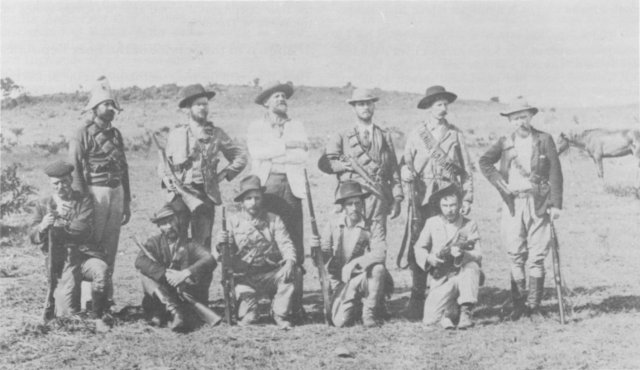
Officers of the Irish Brigade
outside Ladysmith in 1899.
The South African Irish Regiment
At the outbreak of World War 1 in August
1914 three officers met at the Irish Club in Johannesburg with a view to
raising an Irish regiment from among the citizens of Johannesburg and its
environs. They were Maj George Twomey, Capt J. Jeoffreys, and a Capt MacDonald.
Authority was granted by Defence Headquarters and Lt Col Brennan, VD (Volunteer
Decoration), was appointed as Commanding Officer, with Maj Twomey as Recruiting
Officer. Recruits were quickly found and the battalion formed up at Booysens
Camp, Johannesburg, on 9 September 1914, its establishment consisting of
six companies. The Honorary Colonel was Mrs Louis Botha, who was an Irish
girl (formerly named Emmett), and the wife of the General.
According to Military Archives the date of the formation of the unit is 1 December 1914. This date, however, is disputed and it would appear that the claim to have been established on 9 September 1914 is recognized as valid. The South African Irish Regiment was a unit within 4 South African Infantry Brigade in Col Skinner's Northern Force and embarked from Cape Town on 21 December 1914. The Force landed at Walvis Bay on the morning of 25 December 1914, and was immediately in action. On 26 December 1914 outposts of the South African Irish came into contact, and conflict, with German patrols. Hence, the unit was in action three months after it was raised. On 11 February 1915 the Northern Force came under the command of Gen Louis Botha.
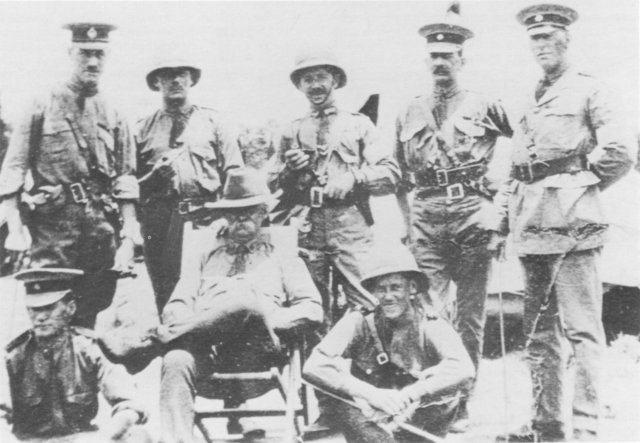
South African Irish Officers in Pretoria 1914.
Lt.Col. F.H. Brennan seated in chair and
Capt (later Major) G.Twomey standing right.
With the close of the SWA Campaign Active Citizen Force regiments were not permitted to proceed, as such, to other theatres of war. War service units were created for East Africa and Europe, and the South African Irish Regiment was formed, together with elements from other units, into the composite 9 South African Infantry ('Sportsmen's') Battalion. 9 Battalion campaigned in East Africa, where it earned the Honours 'Kilimanjaro' and 'East Africa 1916-17'. Maj Twomey became a double Company Commander with 9 Battalion. It is of interest to note that the appellation 'Sportsmen's Battalion' was largely due to the influence of Maj Twomey, who was extremely active in South African sport and prominent in the South African Amateur Boxing Association, the South African Athletics Association, and the South African Olympic Games Association. He also won the first road race between Johannesburg and Pretoria. Maj Twomey naturally attracted to the South African Irish many prominent sportsmen from Johannesburg and elsewhere. It is a matter of some pride to the Regiment that Maj Twomey's son, Cmdt C.A. Twomey, SM, JCD, commanded the unit for many years and later became its Honorary Colonel.
The dress for the South African Irish in 1914-15 shared the common features of the uniform of South African military forces, and as with many other units on active service the slouch hat or sun helmet was worn. However, a green shamrock cloth patch was worn on the left hand side of the hat or helmet. The badge was produced locally and worn on the cloth patch, and also as collar badges, this comprised a brass shamrock upon which was stamped 'S.A. IRISH'.
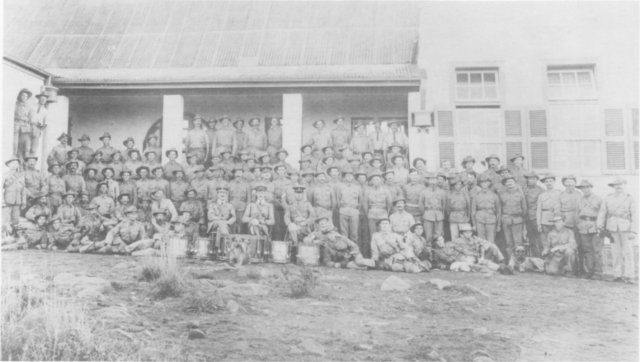
6 Coy South African Irish in Pretoria 1914.
Presentation photograph to Mrs Louis Botha,
Honorary Colonel of the Regiment
On Saturday, 29 January 1921, at Milner Park, Johannesburg, the South African Irish Regiment was presented with the King's Colour by Prince Arthur of Connaught, the (then) Governor-General of the Union of South Africa, in recognition of its service in German South West Africa. The Colour was hung in the old St Mary's Cathedral, Johannesburg, but was, most regrettably, lost when the Cathedral moved from what is now Darragh House to its present site; and, despite the most intensive inquiries, cannot now be traced.
In 1939 the First South African Irish Regiment was reformed through the efforts of Maj Twomey, Capt Jeoffreys and Capt Cullinan (son of Sir Thomas Cullinan, of diamond fame). Cullinan was the Transport Officer in East Africa and later the Honorary Colonel of the Regiment. The unit was designated as the First South African Irish but, in fact, a Second Battalion was never formed, for men intended for this Second Battalion were drafted to the First. Thus, the usual designation was simply 'South African Irish'.
HQ, Support Company and 'A' Company were recruited in Central Johannesburg, 'B' Company on the East Rand and 'C' Company on the West Rand. A pipe band was formed, the pipes and music being obtained in Eire and the personnel wearing saffron kilts and green stockings. The regimental mascot was, predictably, an Irish terrier.
In November 1939 the Union Defence Forces had approved of the formation of the unit and two months later parades were held and details forwarded to the South African Military College at Roberts Heights concerning courses of instruction.
In April 1940 the regiment, under Lt Col J.A. Moreland, MC, trained at Premier Mine, being brigaded with the Imperial Light Horse and Pretoria Regiment. On 16 June the South African Irish was mobilized under the command of Lt Col D.I. Somerset, MC, and, together with 2 Botha Regiment and 3 Transvaal Scottish, formed 5 South African Infantry Brigade. In July the Brigade moved to Barberton for further training and, after being fully motorized, proceeded via Durban to Kilindini on the Llanstephan Castle. After concentrating at Gilgil in Kenya, the South African Irish took part in the invasion of Southern Abyssinia (1 February 1941) and distinguished itself at El Gumu, Hobok, and Banno early in February 1941. The regiment also participated in the capture of Mega (18 February 1941). Among the casualties resulting from this action was the Second-in-Command, Maj Ward Clare. The South African Irish then returned with other units of 5 Brigade to Kenya and, embarking at Mombasa on 18 April, reached Suez on 1 May 1941. After some time at Amirya the unit proceeded to Mersa Matruh on 23 May and remained in the vicinity until October. At the end of August a number of members of the unit were granted leave to South Africa, their places being filled by reinforcements from other units; e.g., 2 Witwatersrand Rifles. Morale at this time was excellent.
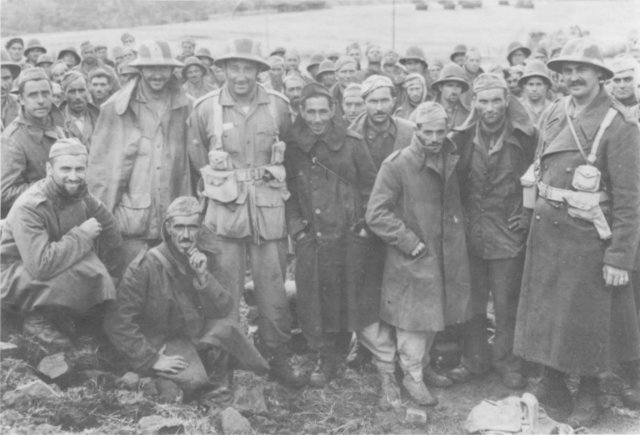
After the capture of Mega in 1941.
Sergeant Majors Brehem, Foster and Owen
with Italian prisoners.
In November the long awaited invasion of Libya and the relief of Tobruk was scheduled. The South African Irish, with its sister units, the 2 Botha and 3 Transvaal Scottish, together with the Transvaal Horse Artillery, were enmeshed in the defeat at Sidi Rezegh on 23 November 1941, when the German panzers overwhelmed 5 Brigade and 'plunged straight into Egypt.' The casualties of the South African Irish were heavy, and included among its number the OC, Lt Col Dobbs; only 140 men escaped the disaster. Maj C. McN. Cochran, who succeeded Lt Col Dobbs, was wounded. Several members of the unit were drowned whilst en route to Italy by ship, as prisoners-of-war. Until the end of November the survivors served with New Zealand forces; after this date they rejoined the decimated Brigade at Mersa Matruh.
In February 1942 the South African Irish and 3 Transvaal Scottish ceased to exist as independent infantry units and the remnants were drafted either to the Regiment Botha or to the South African Artillery. As 11 Battery, 4 Field Regiment, South African Artillery, the Irish were once again in action at El Alamein, and fired their first shot in the engagement on 24 September 1942, at 22h00. In 1943 the unit returned to the Union of South Africa, to become 4/22 Field Regiment, South African Artillery. In this form it returned to North Africa as a component of 6 South African Armoured Division, later serving in Italy.
In recognition of its services during World War 2 the Battalion received the following battle honours:
These honours were not awarded immediately upon publication of the official order, as was the case with other infantry battalions, because, at the time of publication, the unit was an artillery regiment and, as such, did not carry any Honours. However, with its reconversion to an infantry unit it became entitled to Honours that had previously been earned by it and they are now incorporated in the colour of the Regiment presented to them by the State President in 1968. At the end of World War 2, in view of the resurrection of Active Citizen Force units, Col Cullinan requested that the Regiment be reformed as an infantry unit. As there was no intention at that time to establish additional Active Citizen Force infantry battalions, the request for the re-establishment of the South African Irish in the form of an infantry regiment was refused. Nevertheless, authority was granted for the formation of an artillery unit, to be designated 22 Field Regiment (South African Irish) South African Artillery. Such a unit was formed in June 1946 and operated until 31 December 1959 as an artillery regiment, its members (drawn from ballotees residing in Johannesburg) wearing the gunners's insignia. On 1 January 1960 the Regiment reverted to its original infantry role and regained its old title, 'The South African Irish Regiment.' In this form it was involved in controlling the disturbances of 1960-1961 in South Africa. The Freedom of the City has been conferred upon the South African Irish Regiment by both the Johannesburg and Barberton Municipalities, in the former case cementing the long and close ties between the city and the Regiment.
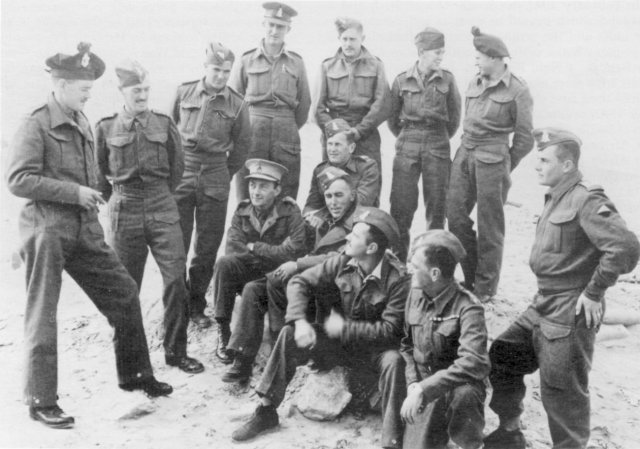
A group of officers
who returned to Mersa Matruh
after the battle of Sidi Rezegh.
Traditions and Curios of the South African Irish Regiment
Upon the re-formation of the Regiment in 1939 a Pipe Band was raised,
under Pipe Major Foster, remaining with the Regiment until 1949, after
which it became the South African Irish Regimental Association Pipe Band.
The Regimental march was 'The County Down Militia 'but it has now been
changed to 'Killaloe'. Upon its reconversion to an Infantry regiment the
only change in dress resulting was the return of the original cap badge,
the crowned harp and motto, to all non-commissioned ranks. In 1961, following
the institution of the Republic, the crown was removed from the badge.
At a later date a new badge minus the crown was produced in Pretoria, to
be worn by all non-commissioned ranks, officers continuing to wear the
original badge, minus the crown, which was of silver. At this time the
caubeen (a headdress exclusive to Irish regiments) was replaced by the
green beret. Between the accession of Queen Elizabeth II(1952) and the
institution of the Republic, the St Edward's Crown was worn by Majors and
Warrant Officers on the shoulder straps and sleeves. Chrome South African
infantry buttons continued to be worn, but with one unusual distinction.
Cmdt Twomey decided that, in remembrance of the time when the Regiment
was an Artillery unit, the top left hand cuff button on the khaki jacket
should be a chrome South African Artillery button. As a further memento
of the time when the Regiment was an Artillery unit, Sam Browne belts were
not worn for walking out.(9)
The South African Irish Regiment was allied in 1940 to the London Irish Rifles, and after the war former prisoners-of-war met their comrades in London. In 1949 the affiliation between the two Regiments was announced.
The Regiment at present stands 16th in order of precedence amongst the infantry battalions of the Citizen Force. This precedence, however, may be elevated if a claim to an earlier date of establishment is officially recognized. The original motto of the Regiment in 1914 was that of the Royal Irish Rifles (later the Royal Ulster Rifles), 'QUIS SEPARABIT?') ('Who will separate us?'). During World War 2 it changed to 'FAUGH-A-BALLAGH' ('Clear the way'), which has remained to the present time. The motto echoes the history of the Royal Irish Fusiliers the First Battalion of which were known as the 'Faugh-a-Ballaghs', an honorary title conferred upon them during the Peninsular War (1809-1812). Indeed, until their amalgamation in the 1960s (with other regiments of the North Irish Brigade, the Royal Irish Rangers), they were still commonly referred to as the 'Faughs'.
Conclusion
With some justification perhaps the South African Irish Regiment may
be referred to as 'the elusive regiment' in two major respects. Firstly,
one has its recurring characteristic of disbandment and re-establishment;
its disappearance following the close of World War 1, and reformation in
1939. Secondly, one notes the chameleon-like character of the Regiment,
changing from an infantry to an artillery unit, and then reconverting to
an infantry unit once again. However, despite this constantly changing
complexion (which now, one assumes, has ended, with the firm establishment
of the Regiment as an infantry unit in 1960) the echoes of the Irish tradition
in South African military history remain a consistent feature of the Regiment's
history. Those echoes may be defined in terms of tenacity and daring, which
nobody could deny to the South African Irish.
Bibliography
| DECORATIONS AND AWARDS OF THE SOUTH AFRICAN IRISH REGIMENT AND ITS PREDECESSORS | ||||
|---|---|---|---|---|
| Award | Recipient | Unit | Gazetted | |
| Anglo-Boer War 1899-1902 | Distinguished Service Order | Driscoll D.P. Capt | Driscoll's Scouts | 19/4/01 |
| Smith C.F. Capt | Driscoll's Scouts | 31/10/02 | ||
| World War I | Military Cross | Montgomery H. QM/Capt | SA Irish | 22/8/18 |
| Taylor R. McG. Capt | SA Irish | 22/8/18 | ||
| Woon E.W. Capt | SA Irish | 22/8/18 | ||
| Distinguished Conduct Medal | 659 Murray J. RSM | SA Irish | 22/8/18 | |
| World War II | Distinguished Service Order | 87602 Cochran C. McN. Maj | 2 RB and SA Irish | 24/2/42 |
| Military Cross | 87602 Cochran C. | SA Irish | 30/12/41 | |
| British Empire Medal | 88646 Mulder A.H. L/Cpl | SA Irish | . | |
| 88567 Ritchie J.A. Pte | SA Irish | . | ||
| Distinguished Conduct Medal | 11231 Thayer H.H. Pte | 1st SA Irish | . | |
| Military Medal | 88805 Brand J.B. Pte | SA Irish | 24/2/42 | |
| 82214 Brislin J.J. Pte | SA Irish | 24/2/42 | ||
| 87641 Burton R.V. Pte | SA Irish | 24/2/42 | ||
| 88792 Buys L.J. Pte | SA Irish | 24/2/42 | ||
| 87642 Callaghan D.J. Pte | SA Irish | 30/12/41 | ||
| 87990 Kirk J.R. Cpl | SA Irish | 21/10/41 | ||
| 16481 Lubbe J.H.B. Sgt | 1st SA Irish | . | ||
| 88344 Macaulay J.I.E. Cpl | 1st SA Irish | . | ||
| 89049 Muller F. Pte | SA Irish | . | ||
| 88941 Shaw J.C. Pte | SA Irish | 3/8/44 | ||
| 88320 West R.M. Pte | SA Irish | 24/2/42 | ||
| 89022 Winterbach B. | SA Irish | 24/2/42 | ||
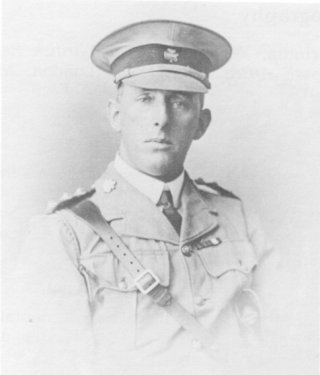
Major George Twomey co-founder of the
S.A. Irish in 1914 and 1939.
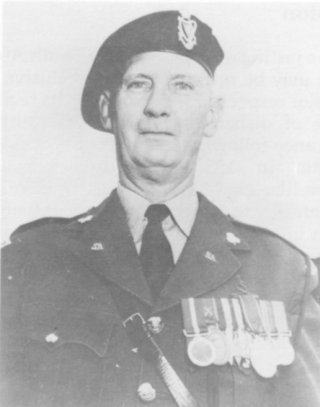
Col. C.A. Twomey, son of Maj G. Twomey
commanded the Regiment between 1956 and 1965
and became Honorary Colonel in 1977.
| HONORARY COLONELS,COMMANDING OFFICERS AND REGIMENTAL SERGEANT MAJORS | |
|---|---|
| Honorary Colonels | |
| Col (Mrs) Louis Botha | 1914-1915 |
| Col T.W. Cullinan | 1945-1953 |
| Col W.J. Busschau | 1966-1976 |
| Col C.A. Twomey, SM, JCD | 1977-1978 |
| Commanding Officers | |
| Lt-Col F.H. Brennan, VD | 1914-1915 |
| Lt-Col J.A.M. Moreland, MC | 1939-1940 |
| Lt-Col D.I. Somerset, MC | 1940 |
| Lt-Col J.F.K. Dobbs, MC | 1940-1942 |
| Lt-Col C. McN. Cochran, DSO, MC | 1942 |
| Lt-Col F.H.G. Cochran, OBE, ED | 1945-1951 |
| Lt-Col J. Geber, DSO | 1951-1956 |
| Cmdt C.A. Twomey, SM, JCD | 1956-1964 |
| Cmdt G. van Kerckhoven SM, JCD | 1965-1969 |
| Cmdt E.M. Kristal, JCD | 1970-1972 |
| Maj (T/Cmdt) C.I. Steyn | 1972-1975 |
| Cmdt S.W.J. Kotze | 1975 |
| Cmdt J.C. Bosch | 1975-1980 |
| Cmdt J.H. Swanepoel | 1980-1982 |
| Cmdt S.H. Moir | 1982- |
| Regimental Sergeant Majors | |
| WOl J. Murray, DCM | 1914-1915 |
| WOl R. Bowker | 1939-1940 |
| WOl E. Owen | 1940 |
| WOl A.H. Brehem | 1940-1941 |
| WOl C.E. Whillier, MM, EM | 1946-1955 |
| WOl A. du Preez | 1955-1960 |
| WOl J. Bartman | 1960-1961 |
| WOl R. Parks | 1961-1962 |
| WOl P. Halroyd | 1962-1964 |
| WOl F. Ferreira | 1964-1966 |
| WOl J.L. Fitzhenry | 1967-1977 |
| WOl A.L. Day | 1977- |
Return to Journal Index OR Society's Home page
South African Military History Society / scribe@samilitaryhistory.org